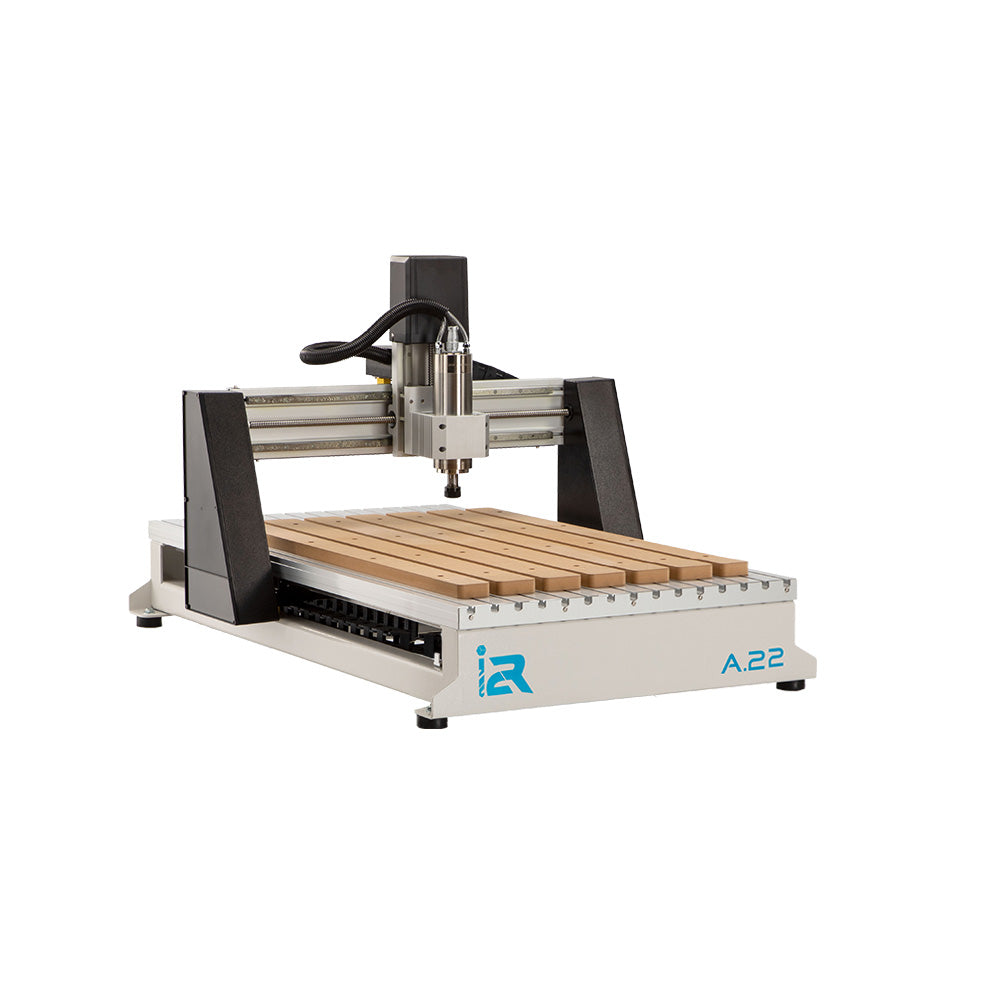Education: How CNC Machines are Invigorating STEM Programs in High Schools
 |
The future of manufacturing depends on the next generation being excited about making things. Here is how one STEM program in Nevada is future proofing their program with their i2R CNC. We took a moment to get to know the amazing students at Reno High School out of Nevada where over the course of their three-year engineering program, students engage in topics, concepts, and projects relevant to all the major engineering disciplines.
Can you introduce yourself and share your background with us?
My name is Karl Kuhles and I am a Career and Technical Education teacher at Reno High School in Reno, NV. I teach the three-year Project Lead the Way Civil Engineering & Architecture Program, wood shop, and computer literacy. In my former life I worked as a geotechnical engineer in Fairbanks, Alaska after graduating with a BS in Civil Engineering from Cal Poly, San Luis Obispo. My goal is to bring my experience as an engineer into the classroom to create opportunities for students to apply what they have learned through real-world, hands-on projects and lessons.
 |
"While my i2R-4 is the first CNC I have used, I am incredibly impressed with the quality, capability, and affordability of the machine and I know it will fulfill all of my classroom’s needs for years to come. The versatility of their platform makes it easy to add upgrades and change capabilities at any time which alleviates the issue of large, prohibitive one-time costs. Not only is the machine of exceptional quality, i2R’s support team is extremely helpful and they have continually demonstrated a vested interest in resolving any issues that I have had. It is satisfying to work with a company that truly stands behind their product and genuinely cares about its users. I have found i2R CNC to be unique in that they can provide equipment tailored to the needs of CNC professionals, small businesses, hobbyists, and even school teachers." |
Tell us a bit about your community and its students on what they’re learning?
My wood shop and engineering program is open to any student that wants to gain hands-on experience designing, building, and problem solving. The ultimate goal is for students to take what they have learned in a classroom setting then apply it to creating something real they can take with them. As advanced tool technologies become more common and available, my goal is to provide students with a working knowledge of CNC equipment, while also giving them experience with traditional manual tools, and the appropriate application of each. I want to provide my students with a breadth of skills and knowledge to give them a leg-up in whatever field they choose to pursue.
|
|
|
Over the course of the three-year engineering program, students engage in topics, concepts, and projects relevant to all the major engineering disciplines. In Year 1, students focus on the engineering design process, CAD and hand drafting techniques, and apply these skills over a variety of projects that familiarize them with tolerance, ergonomics, mechanizing motion, and both additive and subtractive manufacturing. During Year 2, students explore key concepts in mechanical, civil, electrical engineering such as truss analysis, circuit design, simple machines, and robotics. In Year 3, students take a deep dive into civil engineering and architecture, and learn the fundamentals of residential home design, foundation engineering, steel beam design, surveying, water and wastewater systems, soil mechanics, ethics, and the principles and elements of architectural design.
  |
How are you educating students with CNC technology? I am currently developing a unit of study for my level one engineering students to provide an overview of the CNC machining process from CAD design to the physical mill and cutting operations. We discuss the file types that can be interpreted by CNC software, applications of different toolpath operations, accounting for tool dimensions, workflow, basic G-code, and above all, safety. Depending on the size of the class, I introduce students to our classroom’s equipment either individually, or in small groups, and make sure everyone gets their hands on for some portion of the operation. I emphasize that CNC equipment will do exactly as it is programmed, which is why I teach my students to double and triple-check their material, UCCNC, and toolpath setups before selecting “Cycle Start.” |
What was your biggest problem that you and your students had before getting the CNC and how did it solve your problem?
A cornerstone of career and technical education is to provide students access to technology and equipment they would encounter in industry. While most of my students are already familiar with additive manufacturing via 3D printing; CNC milling equipment, and subtractive manufacturing is still rare in the classroom. As both these technologies advance, a wider range of careers and industries apply them for their specific needs. In order to best prepare my students for their futures, I need to provide them with every learning opportunity I can. Our classroom’s i2R-4 CNC gives my students access to milling, laser cutting, and even milling with a 4th-axis. I believe these opportunities will give them a leg-up on the next step of their journey.
Lastly, as a teacher that relies heavily on projects for students, I was used to purchasing pre-made “kits” for many of the lessons and activities I do with my students. While these kits were well made, they would always eat up a big part of my budget. Now, with our CNC, I am able to manufacture many of these kits for a fraction of the price, and I can use the savings to better maintain my existing equipment and purchase materials for more projects that we could not previously afford.
 |
 |
Why did you choose to go with i2R CNC?
As a public-school teacher on a limited budget, I need to find supplies and equipment that are both affordable and durable. I’ve wanted a CNC machine for my shop and engineering courses for years, but I had trouble finding a quality machine my program could afford. I eventually found i2R and was impressed by the features and capabilities of their machines, all within my district’s budget limits. Everyone at i2R was incredibly helpful with purchasing and customizing my order to best fit my classroom’s needs. Since receiving our i2R-4 machine in Fall 2020, it has been an absolute workhorse for my students.
|
|
|
What do you like about CNC?
The best part of CNC is the potential it creates. If a student puts the time into their design and creating their mill operation, they can produce professional-quality work. Especially now with powerful CAD post-processors, students can let the computer generate their G-code for them, and they can focus on proper setup and execution of the code.
|
What type of projects are students making on the machine? As a teacher, I am constantly still finding new ways that students can utilize the technology and can experience with CNC. Personally, I’ve always enjoyed hand-made games and puzzles, so this year I had my engineering students create their own “Gipfelstürmer” or “Mountaineer” marble games. This project requires them to use hand-tools, 3D-printers, with an emphasis on our CNC to create intricate mazes for their “Mountaineer” to climb. My shop students created their own “tilting marbles mazes” and utilized the CNC’s laser to mark locations of walls for their designs. My students have also helped me design and mill award plaques for coaches at our school. |
 |
 |
 |
 |
Is CNC intimidating for your students?
Without any introduction or background, I would say yes, CNC is intimidating for students. It is a big, powerful machine, with a complex UCCNC software interface. It looks industrial and professional, because well, it is. I teach my students to always respect, but never fear equipment, and at first glance, the CNC in operation is a lot to take in. However, after I have had time to explain the theory behind CNC milling, go through the UCCNC software controls, and explain the safety procedures, they love it. They realize that as a whole, the system is complex, but they understand how each small part works together to produce a CNC’ d product.
 |
What materials do you cut?
As my classroom is primarily set up as a wood shop, my students and I primarily use our CNC on wood and engineered wood products. However, I want to expand projects to include plastics and aluminum. Was CNC easy to learn? I will say that our i2R-4 CNC was relatively easy to get started with and perform basic mill operations. i2R’s “Checklist Before You Hit "Cycle Start" On your CNC” was a huge help for my students and me. As you dive deeper into the machine’s full capabilities, extra research, focus, and planning are a must; however, the work that can be produced is well worth the effort. |
Have you seen a beneficial impact with your students?
Yes! When new students join my program or enter my shop, they are always immediately drawn to all the “cool stuff” at their disposal: tools and equipment they don’t see in a typical classroom. The item that always gets the most attention of course is our i2R CNC. I have noticed the satisfaction on my students’ faces when they remove their work from the mill, knowing it is something they have created entirely themselves.

|
Would you recommend i2R CNC and why?
While my i2R-4 is the first CNC I have used, I am incredibly impressed with the quality, capability, and affordability of the machine and I know it will fulfill all of my classroom’s needs for years to come. The versatility of their platform makes it easy to add upgrades and change capabilities at any time which alleviates the issue of large, prohibitive one-time costs. Not only is the machine of exceptional quality, i2R’s support team is extremely helpful and they have continually demonstrated a vested interest in resolving any issues that I have had. It is satisfying to work with a company that truly stands behind their product and genuinely cares about its users. I have found i2R CNC to be unique in that they can provide equipment tailored to the needs of CNC professionals, small businesses, hobbyists, and even school teachers.







